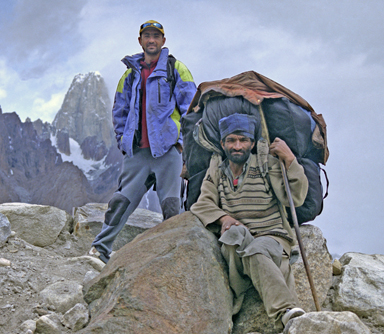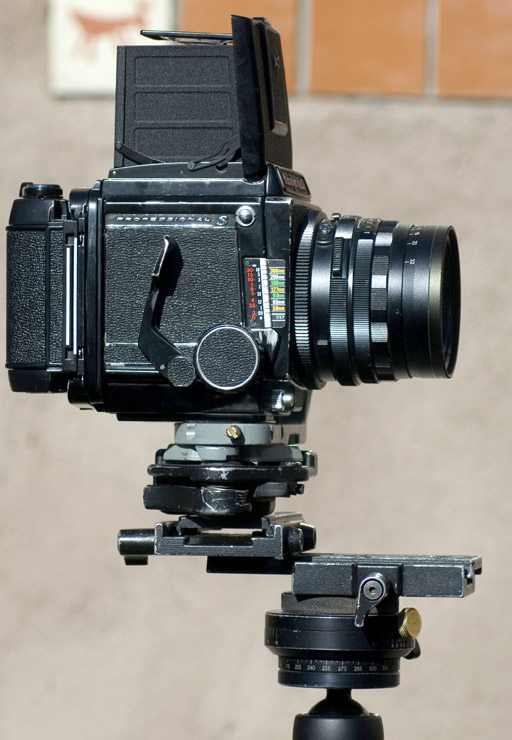|
|
|
|
| But that has changed. I now use a Nikon D200 Digital SLR or a Mamiya 60 mm x 70 mm film camera much of the time. I still often use a lightweight Nikon N65 35 mm film camera when backpacking without porters or horses. And sometimes I just bring a monopod along on a hike instead of a tripod.
|
 My "dosts" (friends) Balti tribesmen Ibrahim Shahid, guide, and Nak-sha Ali, porter, rest along the Baltoro Glacier beneath 6109 meter (20,042 ft.) Uli Biaho Tower in the Baltoro Mustagh, Baltiyul, Pakistan. About a year ago when I was collecting equipment for an expedition to K2 in the Karakoram mountains of northern Pakistan, I decided to buy a set of medium format gear so I would have the option of making poster size prints when I came back. The image to the right is of a Mamiya RB67 with a 50 mm wide angle lens, rotating back and waist level viewfinder. This camera is a tank, very tough, and the format, 60 mm x 70 mm, turns out to be ideal for panoramic work. The camera is completely manual and does not use batteries of any kind. It does add about 5 pounds to my backpack to carry this camera, but thanks to my buddy, Nak-Sha Ali, that was not a problem on the K2 trip!
| 
|
| When I use a 50 mm lens on my Mamiya RB 67, it pulls in the detail the same as a 50 mm on my Nikon 35 mm camera. But since the negative is more than twice as wide in the portrait mode, 60 mm instead of 24 mm, I only have to shoot 9 shots instead of 24 to provide adequate overlap for the 360 degree coverage I want. And, since the negative is twice as tall, 70 mm instead of 35 mm, I get coverage vertically which would necessitate 3 rows around with a 35 mm camera. Because of the need for overlap, just two 35 mm rows would not cover the vertical amount of your scene that a 70 mm capture area will - THREE rows would be required. So, instead of needing 72 images (24 each row, x 3 rows) with a 35 mm film camera, I only need 9 shots with the 60 mm x 70 mm medium format camera to shoot the same pano. This more than compensates for the extra cost of the medium format film and processing. And with the D200 digital, which has a 23 mm x 15 mm capture area, I would need 4 or 5 rows of 36 shots each to cover the same area, which is as much as 180 exposures instead of the 9 I need with the Mamiya. That's TWENTY times as much work! At K2 I shot a row up and a row down with the Mamiya, 20 shots in all, which gave me tremendous coverage. Mamiya has released a digital back for the RB67 that creates 24 megapixel files, the same size my scanner produces from 60 x 70 mm film exposures, but the capture area is only 4.5 mm x 60 mm. The back is priced at $25,000. I would not be comfortable putting a $25,000 back in a duffel bag strapped loosely to the side of a donkey on the crevassed ice of the Baltoro glacier!
|
|
|
|
|
|
|
|
|
|
|
|